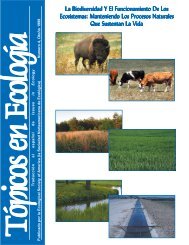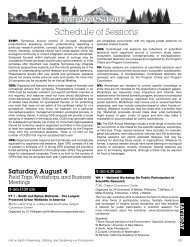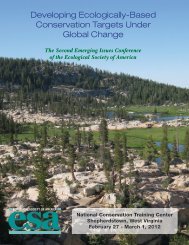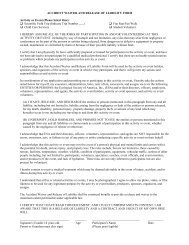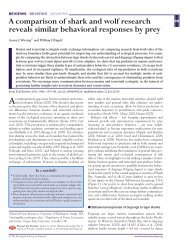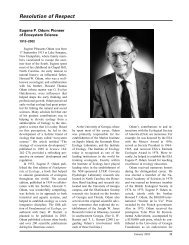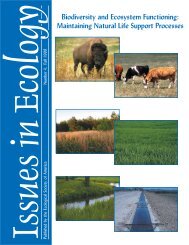Printed Program (PDF) - Ecological Society of America
Printed Program (PDF) - Ecological Society of America
Printed Program (PDF) - Ecological Society of America
Create successful ePaper yourself
Turn your PDF publications into a flip-book with our unique Google optimized e-Paper software.
Forest Service. Climatic effects on a non-native amphibian<br />
in Hawaii Island: Survivorship along an elevational gradient.<br />
PS 77-132 Katz, DW and I Ibanez, University <strong>of</strong> Michigan. Plant<br />
range expansion and biotic interactions: An experimental<br />
approach.<br />
PS 77-133 Miller-Struttmann, N, JD Franklin and C Galen, University<br />
<strong>of</strong> Missouri. Does history repeat itself? Tracking change in<br />
resource use by alpine bumblebees with global warming.<br />
PS 77-134 Stine, AW1, C Salk2 and JS Clark1, (1)Duke University,<br />
(2)University <strong>of</strong> Colorado. Don’t judge a leaf by its color:<br />
Warming is not delaying end-<strong>of</strong>-season processes in some<br />
deciduous tree species.<br />
PS 77-135 Theobald, EJ and J HilleRisLambers, University <strong>of</strong><br />
Washington. Life at the limit: Pollen limitation <strong>of</strong> an early<br />
flowering lily (Erythronium montanum).<br />
PS 77-136 Garcia, CL and K Williams, California State University, San<br />
Bernardino. Phenological shifts in flowering in southern<br />
California under El Niño conditions (1976).<br />
PS 77-137 Enquist, CAF1, SL Young2 and J Weltzin3, (1)USA<br />
National Phenology Network & The Wildlife <strong>Society</strong>, (2)U.S.<br />
Geological <strong>Society</strong>, (3)USA National Phenology Network.<br />
Observed changes in phenology across the US: A regional<br />
review for the National Climate Assessment.<br />
PS 77-138 Putnam, RC and PB Reich, University <strong>of</strong> Minnesota.<br />
Understanding range limits: Climate, competition, and<br />
patterns <strong>of</strong> survival for three sugar maple populations<br />
experimentally planted from Arkansas to Ontario.<br />
PS 77-139 Bailey, CM and DJ Grisé, Texas A&M-Corpus Christi.<br />
The effects <strong>of</strong> climate and land use patterns on species<br />
presence and abundance for the Flour Bluff, TX Christmas<br />
Bird Count.<br />
PS 77-140 Saltré, F1, SL Shafer2 and PJ Bartlein3, (1)Oregon State<br />
University, (2)U.S. Geological Survey, (3)University <strong>of</strong><br />
Oregon. Simulated vegetation responses to potential future<br />
climate change in western North <strong>America</strong>.<br />
PS 77-141 Channell, R and GY Jacquez, Fort Hays State University.<br />
Climate change: Implications for montane mammals <strong>of</strong> the<br />
Great Basin.<br />
PS 77-142 Polgar, C1, RB Primack1, EH Williams2, C Hitchcock3 and<br />
S Stichter4, (1)Boston University, (2)Hamilton College, (3)<br />
Boston College, (4)Massachusetts Butterfly Club. The<br />
effect <strong>of</strong> temperature and precipitation on the timing <strong>of</strong> the<br />
adult flight period <strong>of</strong> Lycenid butterflies in Massachusetts.<br />
PS 78 - Climate Modeling<br />
Exhibit Hall DE, Oregon Convention Center<br />
PS 78-143 Schuur, EAG1, AD McGuire2, J Canadell3, JW Harden4, P<br />
Kuhry5, V Romanovsky6, MR Turetsky7 and C Schaedel1,<br />
(1)University <strong>of</strong> Florida, (2)University <strong>of</strong> Alaska Fairbanks,<br />
(3)CSIRO Marine and Atmospheric Research, (4)United<br />
States Geological Survey, (5)Stockholm University, (6)<br />
University <strong>of</strong> Alaska, (7)University <strong>of</strong> Guelph. Vulnerability<br />
<strong>of</strong> permafrost carbon: Results from a research coordination<br />
network survey.<br />
PS 78-144 Koncki, NG and MFJ Aronson, H<strong>of</strong>stra University.<br />
Increased invasion risk in a warmer world: Modeling the<br />
range expansion <strong>of</strong> three <strong>of</strong> the most problematic aquatic<br />
invasive plants in the United States with climate change<br />
using MaxEnt.<br />
PS 78-145 Phillips, DL1, RJM Boumans2, TD Fontaine1, CA Burdick1<br />
and W Victery1, (1)U.S. Environmental Protection Agency,<br />
(2)AFORDable Futures LLC. Developing a model for effects<br />
<strong>of</strong> climate change on human health and health-environment<br />
interactions: Heat stress in Austin, Texas.<br />
PS 78-146 Todd-Brown, KE1, JT Randerson1, WM Post2 and SD<br />
Allison3, (1)University <strong>of</strong> California, Irvine, (2)Oak Ridge<br />
National Laboratory, (3)University <strong>of</strong> California. Evaluating<br />
soil carbon in Earth system models: How good are the<br />
models and what drives model variability?.<br />
PS 79 - Agroecology<br />
Exhibit Hall DE, Oregon Convention Center<br />
PS 79-147 Larsen, EM, North Carolina State University. Effect <strong>of</strong> longterm<br />
agroecosystems on soil biological properties and<br />
carbon losses.<br />
Life on Earth: Preserving, Utilizing, and Sustaining our Ecosystems<br />
4:30 pm-6:30 pm<br />
PS 79-148 Ghersa, CM1, SL Poggio1, GA Molina1, V Le Féon2 and<br />
F Weyland3, (1)IFEVA/CONICET, Facultad de Agronomía,<br />
Universidad de Buenos Aires, Argentina., (2)IFEVA/<br />
CONICET, Facultad de Agronomía, Universidad de Buenos<br />
Aires, Argentina. INRA Avignon, France, (3)Facultad<br />
de Agronomía, UNMDP. Agricultural mosaics: Novel<br />
ecosystems in the Rolling Pampas <strong>of</strong> Argentina.<br />
PS 79-149 Maczko, K1, JA Tanaka1, J Ritten1, JA Morgan2, N Chhetri3,<br />
LA Hidinger3, MC Reeves4 and JE Mitchell5, (1)University<br />
<strong>of</strong> Wyoming, (2)USDA-ARS, (3)Arizona State University, (4)<br />
USFS Rocky Mountain Research Station – LANDFIRE, (5)<br />
USDA Forest Service, Rocky Mountain Research Station.<br />
Sustainable rangelands: Assessing contributions to food<br />
security and ecosystem services.<br />
PS 79-150 Gibson, DJ1, KL Gage1, JL Matthews1, BG Young1,<br />
MDK Owen2, RG Wilson3, SC Weller4, DR Shaw5 and<br />
DL Jordan6, (1)Southern Illinois University, (2)Iowa State<br />
University, (3)University <strong>of</strong> Nebraska, (4)Purdue University,<br />
(5)Mississippi State University, (6)North Carolina State<br />
University. The effect <strong>of</strong> weed management practices on<br />
weed species communities over 5 years in Glyphosateresistant<br />
cropping systems.<br />
PS 79-151 Paradise, CJ, M Madden, L Hedley, R Clemente and J Kim,<br />
Davidson College. Assessment <strong>of</strong> beetle and bug diversity<br />
in low input cattle farms <strong>of</strong> varying cattle density and<br />
surrounding land use.<br />
PS 79-152 Dugarjav, D and ST Gower, University <strong>of</strong> Wisconsin.<br />
Aboveground net primary productivity and carbon allocation<br />
<strong>of</strong> poplar plantation on well-drained glacial drumlin soil.<br />
PS 79-153 Brym, ZT, Utah State University. Developing an<br />
agroecological approach to biomass scaling and branching<br />
architecture using orchard trees.<br />
PS 79-154 Begley, DR, Wright State University. White-tailed deer and<br />
their vigorous appetite: An empirical study <strong>of</strong> monetary<br />
losses in soybeans.<br />
PS 79-155 Smith, RG and LW Atwood, University <strong>of</strong> New Hampshire.<br />
Is “relatedness” a good predictor <strong>of</strong> suppression <strong>of</strong> weeds<br />
by cover crop mixtures?.<br />
PS 79-156 Dietsch, TV1, MW Chandler1, SC Tanzi2, N Ureña3 and LV<br />
Navarro1, (1)Earthwatch Institute, (2)University <strong>of</strong> Vermont,<br />
(3)Earthwatch Institute, Costa Rica. Engaging a c<strong>of</strong>fee<br />
farmer community in the Los Santos region <strong>of</strong> Costa Rica:<br />
Developing tools for farmers to encourage sustainable<br />
farming practices.<br />
PS 79-157 Numbers, EM, SM Philpott and MN Weintraub, University<br />
<strong>of</strong> Toledo. Correlations between soil quality and arthropod<br />
communities in organically managed farms in NW Ohio.<br />
PS 79-158 Rousseau, L1, SJ Fonte2, O Téllez2, R van der Hoek2 and<br />
P Lavelle2, (1)Insitut de Recherche pour le developpement<br />
(IRD), (2)International Center for Tropical Agriculture.<br />
Biological indicators <strong>of</strong> soil quality and impacts <strong>of</strong> land<br />
use management in agricultural landscapes <strong>of</strong> northern<br />
Nicaragua.<br />
PS 79-159 Brown, MI, J Grossman, W Shi and SC Reberg-Horton,<br />
North Carolina State University. Evaluating termination<br />
methods <strong>of</strong> leguminous cover crops for optimizing nitrogen<br />
synchrony.<br />
PS 79-160 Quinn, JE1 and TN Awada2, (1)University <strong>of</strong> Nebraska-<br />
Lincoln, (2)University <strong>of</strong> Nebraska - Lincoln. Predicting<br />
avian population trends in high intensity agroecoregions.<br />
PS 79-161 Franco, JG, Texas A&M University. Evaluating functional<br />
diversity in an organic intercropping system.<br />
PS 79-162 Schroeder-Moreno, M1, J Grossman2 and K Niewonly3,<br />
(1)North Carolina State University, (2)NCSU, (3)Virginia<br />
Tech. The Sustainable Agriculture Education Association:<br />
Promoting best teaching and learning practices in<br />
agroecology.<br />
PS 80 - Arctic, Alpine, Antarctic Systems<br />
Exhibit Hall DE, Oregon Convention Center<br />
PS 80-163 Saurey, SD, BJ Adams and ZT Aanderud, Brigham Young<br />
University. Exploring C substrate and soil moisture effects<br />
on bacterial diversity through 13C- and 18O-DNA stable<br />
isotope probing in polar deserts.<br />
PS 80-164 Walters, CE and WK Smith, Wake Forest University. Lateral<br />
167<br />
THURSDAY



